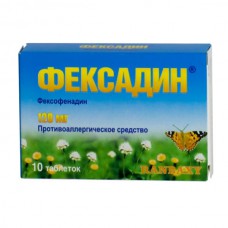Expiration date: 03/2025
The composition and form of issue:
Tablets, film-coated. 1 tablet contains:
Fexofenadine hydrochloride 120 or 180 mg
excipients: croscarmellose sodium MCC pregelatinization starch povidone silicon dioxide colloidal magnesium stearate water purified*
film coating: Opadry pink dye (OY-54957): (hypromellose, titanium dioxide, macrogol 400, colorant iron oxide red (CI No. 77491), purified water*
printing ink: Opacode S-1-27794 black (shellac, dye iron oxide black, N-butanol, purified water , propylene glycol, methylated alcohol 74 OP, isopropanol*)
*evaporates during the production process
in a contour cells packing 10 PCs. in cardboard pack 1 or 2 packs.
Description pharmaceutical form:
Pills 120 mg: biconvex, oval, film-coated pink, with the inscription "FXD 120" printed in black ink on one side.
Tablets 180 mg: biconvex, oval, film-coated pink, with the inscription "FXD 180", printed in black ink on one side.
Pharmacokinetics:
Fexofenadine hydrochloride after oral administration is rapidly absorbed from the gastrointestinal tract, Tmax — 1.3 h. the Average value of Cmax after oral dose of 120 mg — 289 ng/ml, and after taking a dose of 180 mg is approximately 494 ng/ml the plasma protein Binding is 60-70% (mainly to albumin and alpha-1-glycoprotein). It permeates through the GEB. Fexofenadine undergoes partial (5% dose) metabolism.
Excretion is biphasic. T1/2 after multiple dose — 11-15 hours in patients with moderate (Cl creatinine clearance 41-80 ml/min) and severe (11-40 ml/min) renal insufficiency T1/2 increased by 59 and 72% respectively in patients on hemodialysis, the T1/2 increased by 31%. Pharmacokinetics in single and multiple application of Fexofenadine (up to 120 mg twice daily) is linear.
It is excreted mainly (80%) in the bile, up to 10% of the dose excreted unchanged in the urine.
Description pharmacological action:
Fexofenadine hydrochloride is a blocker of H1 - histamine receptors, virtually devoid of sedative action. Fexofenadine is a pharmacologically active metabolite of terfenadine.
Antihistamine effect of the drug manifested through 1 h after administration, reaching a maximum after 6 h and continued for 24 hours . After 28 days of treatment is not observed the development of tolerance. In oral administration of doses from 10 to 130 mg there is a linear dependence "dose-effect". For 24-hour efficacy of the medicine (in allergic rhinitis) sufficient dose to 120 mg. At a dose of 240 mg of the drug does not cause changes in the QT interval.
Indications:
- seasonal allergic rhinitis: sneezing, itching, runny nose, redness of eyes and other hay fever symptoms — table. 120 mg
- chronic idiopathic urticaria: redness, itching and other symptoms of urticaria — table. for 180 mg.
Contraindications:
- giperchuvstvitelnost to any component of the drug
- pregnancy
- lactation
- children's age (till 12 years)
- chronic renal failure.
Side effects:
Headache, drowsiness, nausea, dyspepsia, dizziness.
Rare (less than 1 case per 1,000 assignments) — fatigue, insomnia, nervousness, sleep disorder.
In some cases, — skin rash, urticaria, pruritus, and other hypersensitivity reactions (angioedema, dyspnea).
Drug interactions:
When used together with erythromycin or ketoconazole concentration of Fexofenadine in plasma is increased in 2-3 times. Significant impact on the increase of the QT interval there. Receiving aluminum - or magnesium antacids within 15 minutes before taking Fexofenadine leads to decreased bioavailability of the latter (the time interval between their admission must be at least 2 hours). Does not interact with omeprazole.
Method of application and dose:
Inside.
Adults and children 12 years and older.
For seasonal allergic rhinitis 120 mg 1 time per day.
In chronic urticaria is 180 mg of 1 times a day.
Overdose:
Symptoms: dizziness, drowsiness and dry mouth.
Treatment: in case of overdose recommended standard measures to remove unabsorbed from the gastrointestinal tract of the drug, symptomatic and supportive therapy. Hemodialysis is ineffective.
Special instructions:
In patients older or patients with hepatic insufficiency Fexofenadine should be used with caution due to the lack of data. It is recommended that the time interval between the reception of Fexofenadine hydrochloride and antacids containing gidrookisi aluminum or magnesium was 2 hours.
Effects on ability to drive and perform work requiring of concentration of attention. While taking the drug Fixedin performs work requiring high concentration and psychomotor speed reactions (with the exception of people who have unusual reactions to the drug). Thus, before the execution of these works (driving, machinery), you must first check the individual reaction to the drug.



